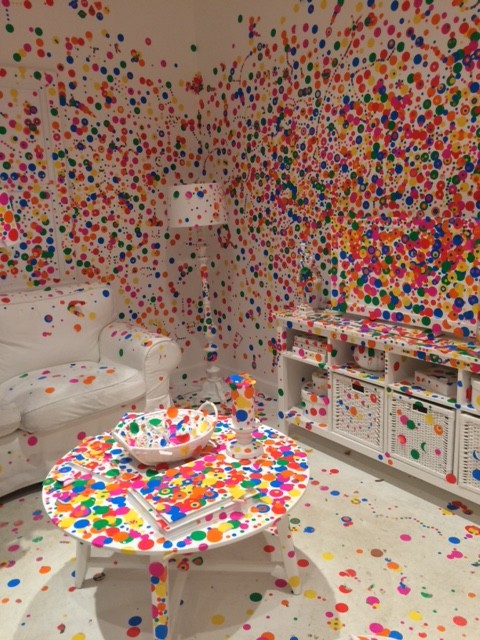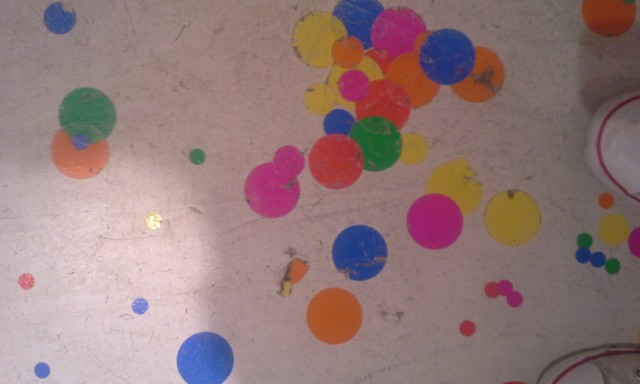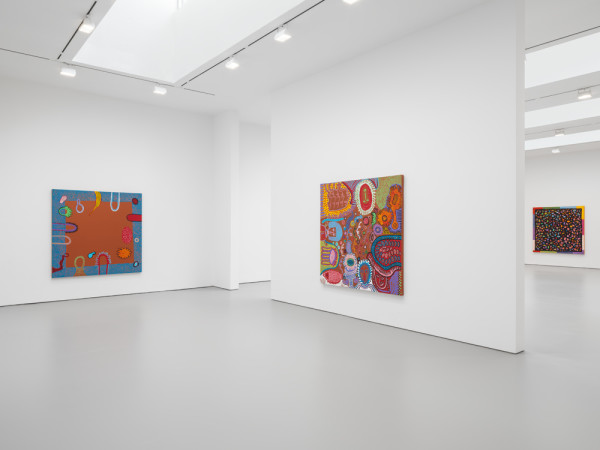Yayoi Kusama: Give Me Love
David Zwirner
519 and 525 West 19th Street
New York, NY 10001
Runs through June 13, 2015
What’s on view: A giant line leading to a garage with a mobile home. Once inside, viewers will see a white dining room and kitchenette covered in dot stickers.
The Obliteration Room
Paddy: So, as was reported, people are lining up to see Yayoi Kusama’s “Obliteration Room.” The draw here is that you get to spend a bunch of time in a white room with a sheet of different-sized and -colored stickers. Your job is to get rid of them. That’s worth waiting in line because you also get to take selfies in the room—which, when I was there, was all anyone wanted to do. It’s a selfie chamber.
This holds appeal to a surprisingly large cross-section of people. When I was there a dude who exited the show with a dot on his forehead; Kusama’s art is bro-friendly.
Corinna: Not just bro-friendly, but kid-friendly, tourist-friendly, and teen-friendly, based on the crowd when I went on Friday. One little girl had her hat covered in stickers; I assume her parents stuck them on.
Paddy: Yeah, there’s nothing wrong with that, but I do wish the art reaching this mass audience was a little more interesting. I didn’t feel any sense of satisfaction when I peeled off the colored dots on my sheet and affixed them to the furniture. It felt like a chore I was tasked.
I recognize that complaint sounds really whiny, but if the stickers don’t even satisfy some visceral feeling, then what possible point could there be to an installation like this?
To my mind, the Amsterdam design collective Moniker provides a much better example of what can be done with stickers in an art-world context. In a work which debuted in 2014 at NADA Miami with P!, visitors were given a sheet of blue glyph-like stickers with rules: they can only be attached to the floor; they must placed next to other stickers that are already in position; the distance between the stickers may not exceed the size of single sticker. The stickers, which resemble parts of the letter P, slowly took over the entrance to the fair. Another piece by the group shown in Gijon Spain, at LABoral, resembles a sprawling electronic network.
The rules for this show are imposed by Zwirner staff. Here, a 20-something art graduate warns visitors not to take away the sticker sheets and another stands at the entrance to collect them. It doesn’t make the sheets seem more precious, though I assume the sheets are collected because the gallery has licensed a limited print run. It’s just another buzzkill for the piece, which let’s face it, is about as trivial as they come.
Corinna: Well, I can’t imagine that there would be as many visitors to Zwirner if they had to abide by rules. But I get it; art needs some rules, and some structure. Instead, the feeling I got when entering the “Obliteration Room” was that I had entered into some soulless, human-size doll house, and instead of being able to interact with the objects in the room—the refrigerator door was painted shut, a hat was “glued” to a rack—all I got were some stickers to play with, like I’m a child.
And play, the visitors did. They had already covered the walls, floors, couches, computer, and everything else in tropical-colored dots. A week after the exhibition opened, the formerly white floor had become covered in dirt, and stickers were peeling off already. It looked gross, but I doubt you can see those gritty details in most of the selfies people were taking.
Paddy: Yeah, I was there one day later, and people were hanging chains of dot stickers from the lights. It looked like a product of boredom.
The Pumpkin Garden
What’s on view: Deeper into the garage, another gallery filled with approximately six people-size, shiny, metal squash covered in dots or holes.
Paddy: No idea what to say about this part of the show. I mean, the pumpkins look great and all, but commenting on them is a little like pontificating on a couch or a chair. They’re just something you put somewhere.
Corinna: Except that these squash might make you want to do something—like take a selfie! There is one nice touch to these veggies: some have solid holes, while some been covered with dots. Without doing a double-take, you might think they’re all dot-covered squash. But really, they just function as selfie-helpers.
Just to note, these are “pumpkins,” according to their titles. As much as both Paddy and I both want to call these sculptures “gourds” or squash”—because that’s what they look like—they are not.
The Painting Gallery
What’s on view: One Zwirner gallery over: colorful, patterned paintings on square surfaces hang from the gallery walls.
Paddy: These paintings are the strongest part of the show. Like all of Kusama’s work there’s a cohesive outsider-like aesthetic—mostly achieved through palette and brushwork—even if the paintings look very different from one another. Some resemble patchwork quilts, others look like monumental doodles or the cartoonish drawings of what one might find under a microscope. All have an obsessive attention to detail. Take all the tiny localized brush marks in “Fear of Youth Overwhelmed by Spring Time of Life,” a sea of hand-painted eyes framed by patches of color filled with dots. I don’t look it and think of anything in the title—it’s just collected iconography—but you can get lost in all the detail. It’s pretty satisfying.
I wonder, though, just how many of those paintings Kusama is producing. She’s 86 years old and lives in a mental hospital. Is she really running her studio so efficiently that she’s able to produce several shows a year? There’s surely some business gossip we’re not privy to here.
Corinna: I wouldn’t be surprised if she doesn’t make these paintings: they seem to abide by some sort of repetitive formula. Despite all the variation of dots, swirls, and eyes, there’s an uninteresting sameness to these works. One work, “My Life,” is masterful; it shows a lavender web of eyes with some semblance of depth, unlike all the other canvases.






Comments on this entry are closed.
{ 1 trackback }